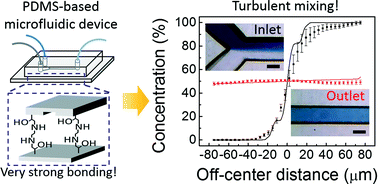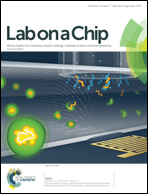PDMS-based turbulent microfluidic mixer†
Abstract
Over the past decade, homogeneous mixing in microfluidic devices has been a critical challenge, because of the inherently low flow rates in microfluidic channels. Although several mixer designs have been suggested to achieve efficient mixing, most of them involve intricate structures requiring a series of laborious fabrication processes. Operation at high flow rates can greatly enhance mixing by induction of turbulence, but devices that can resist such a high pressure drop to induce turbulence in microfluidic channels are difficult to fabricate, especially for commonly used poly(dimethylsiloxane) (PDMS)-based microfluidic devices. We have developed a Y-shaped, turbulent microfluidic mixer made of PDMS and a glass substrate by strong bonding of the substrates to a nanoadhesive layer deposited via initiated chemical vapor deposition. The high bonding strength of the nanoadhesive layer enables safe operation of the PDMS/glass turbulent microfluidic mixer at a total water flow rate of 40 mL min−1, corresponding to a Reynolds number, Re, of ~4423, one of the highest values achieved in a microfluidic channel. The turbulence generated as a result of the high Re allows rapid mixing of the input fluids on contact. Image analysis showed that mixing started as soon as the fluids were introduced into the mixer. The experimental results matched the numerical predictions well, demonstrating that convective mixing was dominant as a result of turbulence induced in the microfluidic channel. Using the turbulent microfluidic mixer, we have demonstrated high throughput formation of emulsions with narrower size distribution. It was shown that as the flow rate increases inside the microfluidic channel, the size distribution of resulting emulsions decreases owing to the increase in the turbulent energy dissipation. The turbulent microfluidic mixer developed in this work not only enables rapid mixing of streams, but also increases throughputs of microfluidic reactors.


 Please wait while we load your content...
Please wait while we load your content...